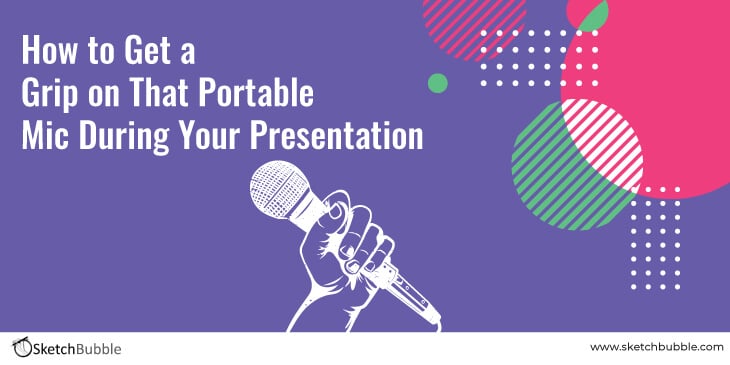
You’ve spent hours preparing for your presentation, so it would be a shame if the audience didn’t hear it the way you intended because of poor microphone skills. Mics may seem easy enough to manage, but if you don’t know how to use the equipment properly, you’re apt to have issues.
In this article, I will cover some portable microphone basics so you will ensure your presentation is heard.
Becoming Familiar with Different Portable Mics
In some venues, you may find you will have to stand behind a podium and use a lectern mic to be heard. This obviously limits a speaker’s mobility, which is why more and more venues are opting for some type of portable mic.
There are three basic kinds of portable mics you will most likely work with:
Handheld
Although wireless, these mics are a bit of a hassle to use because the speaker must hold them the entire time. And, because we all tend to move our arms and hands while we speak, it is entirely too easy to move the mic away from your face, so your audience only clearly hears every third word you say.
Lavaliere Mic
These mics are clipped to your lapel or collar with a battery pack that usually attaches to your waistband. These are quite easy to use and allow you to move about quite freely, arms included. The trick is to not move your head too much. If you constantly turn your head to look at the slides on the screen, be sure to clip the mic to that side of your lapel.
Headset
These are the easiest portable mics to use. Since the unit attaches right to the head, the mic never moves away from your mouth, and you never have to worry or be distracted about where your head needs to be in relation to the mic.
How to Do A Proper Sound Check
Sometimes you may get to the venue and find a technician has already set up the sound system and will actively control the sound levels for that particular-sized room.
In other scenarios, a technician may set up the sound system but leave the rest up to you. In this case, you will need to do a sound check yourself. Make sure you arrive early enough in case a sound check is needed. Even if you are an ace with using mics, every room and every system will present with their own issues and challenges.
Why Mic Rehearsal is Important
You won’t know what kind of mic you’ll be using or if you’ll have tech help until you arrive at the location. Once there, it’s really important to rehearse so you’ll know exactly what the audience will hear when you speak. If you’ll be using a handheld mic, practice holding it close enough to your mouth so it picks up your voice, but not so close that your voice is oddly muffled.
Proper Placement of a Lavaliere Mic
If you’ll be using a lavaliere mic, you’ll want to decide during rehearsal the best place on your body to clip it. Generally speaking, right under your neck is an ideal location to place this type of mic. Men wearing ties can clip the mic right underneath the knot. Women may want to consider wearing some type of blouse with a collar.
And speaking of clothes, avoid wearing any clothes that will rustle or make loud noises. For instance, a nylon windbreaker jacket may be too noisy. You will also want to make sure buttons and jewelry will not clank against the microphone.
How to Avoid Feedback
Getting that high-pitched squeaky feedback over the mic is like nails on a chalkboard to most people. It’s very annoying but easily avoidable if you follow some simple rules:
- When using a handheld mic, if you start to hear feedback, place the mic closer to your mouth NOT farther away from it. When a mic isn’t picking up a strong signal from you, it will pick up other noises, including your voice from other monitors. That is what causes feedback.
- Never place your hand over the microphone. If you need to speak with someone without being heard by the audience, use the mute button.
- Don’t stand near any monitors. Many speakers like to walk about the stage while they speak and that’s fine, as long as you don’t walk by any monitors.
Using the Mute and Off Buttons
As we just mentioned, it’s always best to use the mute button instead of placing your hand over a microphone. And, should you keep a lavaliere clipped on during a break, be sure to turn it off. You don’t need to broadcast a private message or private bathroom time to your audience!
If you keep these portable mic guidelines in mind, you will be sure to come of like a professional, and your audience will be able to enjoy and remember the information you share with them.



